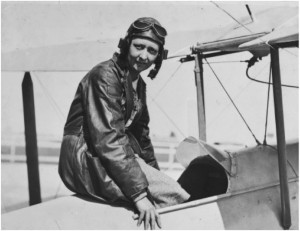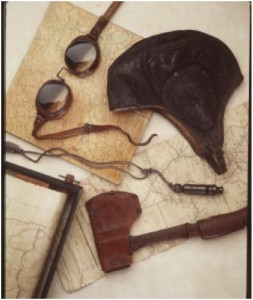This post is written as part of the Women’s History Month Cranky Ladies of History blog tour. If you would like to read more about cranky ladies from the past, you might like to support the FableCroft Publishing Pozible campaign, crowd-funding an anthology of short stories about Cranky Ladies of History from all over the world.
I’m not sure that my pick for this month is really a ‘cranky lady’. She was too much of a lady ever to show crankiness. But she was, shall we say, determined, and I idolised her.
In 1987, in company with Karen Miller, I travelled to Queensland to interview Lores Bonney (pronounced ‘Lorry’) for the Powerhouse Museum. She became a personal hero for me. A bright, funny, intelligent, incredibly brave woman who accomplished enough for three lifetimes.
Never heard of her, right?
But I’ll bet you’ve heard of Amelia Earheart, or Amy Johnson? Lores Bonney was a better pilot than either of them, and flew further and faster. And she was her own mechanic.
Her birth name was ‘Maude’ – Maude Rose Rubens. She was born in Pretoria, South Africa, and left there when she was five, first for England and later for Australia. This was when she changed her name. Her best friend in South Africa was ‘Dolores’, whom everyone called ‘Lores’ (pronounced Laurie). Mourning her lost friend, Lores insisted on being called by the same name. It was a good indication of her strength of will that everyone complied.
Her father was a furniture manufacturer in Melbourne. He just missed overlapping with my great-grandfather, who was also a furniture manufacturer in Melbourne, but who moved to New Zealand at about the same time.
Lores’ father had no great opinion of women, and when the handsome and rather dashing Harry Bonney wanted to marry her, Mr Rubens insisted that Harry first swear that he would never allow her to drive a car. Deeply in love, Harry agreed – but he never promised anything about a plane, so after their marriage, when Lores wanted to learn to fly, he not only paid for lessons, he bought her a Gypsy Moth and had his workshop make her a set of leather flying clothes.
She shouldn’t have got her licence, because she was deaf in one ear from a perforated eardrum. But the doctor doing the test was a friend, she told me, and spoke in the regulation whisper while testing her good ear, but spoke QUITE LOUDLY when testing her bad one.
And she flew – oh, how she flew. Egged on by her husband’s cousin, Bert Hinkler, she set the long distance flying record in Australia (never been broken). She flew from Australia to England in 1933 – and that’s the hard direction, fighting the winds all the way. Even so, if she hadn’t been caught in a thunderstorm on Bang Biang Island and forced to crash land, she would have broken Amy Johnson’s record (Johnson came the easy way, from London to Sydney). After the crash, Lores supervised the repairs, and nonchalantly got back in her battered little De Havilland (nicknamed ‘My Little Ship’) and completed the trip. Why do it the hard way? ‘Because everyone was going the other way.’
And then, just for something to do, she flew from Australia to South Africa. On her own. In a Klemm 32 monoplance. The first person – not the first woman – to do so.
No one else has ever done this. I don’t mean in a Klemm, I mean that no other lone pilot has ever flown from Australia to South Africa. Since 1937.
Not only did she do all this, she did it with grace and flare. Since this was still the days of the Empire, wherever she went she was invited to dinner at Government House, or the District Commissioner’s house, or similar. So she had a special dress made, calf length, with a wide V neck. Then she had a matching floor-length petticoat. If she was invited to afternoon tea, she wore just the dress. If she was invited to dinner, she wore the dress with the petticoat underneath, and it looked like a dinner dress. She washed out her ‘smalls’ in the evening and strung them up on a line in the back of the cockpit to dry as she flew.
And then the war came, and private pilots couldn’t get fuel. Her darling plane was burnt in a fire in the hangar – she always believed it was arson, set by the man who shared the hangar with her, because he couldn’t use his plane but no-one would buy it because of the fuel restrictions. She never piloted a plane again.
Lores told me that she believed that if she ever flew again, she’d crash. She said she’d had a clear message from ‘The Co-Pilot’ (God). But that didn’t stop her having adventures.
After her husband died, she decided she was interested in learning how to make bonsai, so she took herself off to Japan and became the first Westerner to become an accredited bonsai ‘master’.
When she was in her 70s, she went down the Amazon in a canoe.
By the time I met her, she was starting to feel frail. She had decided to donate her memorabilia to the PowerHouse Museum (where I worked) and the interview I taped that day became part of an exhibition about her there.
If you look for the name ‘Lores Bonney’ in the record books, you won’t find it. It will read ‘Mrs Harry Bonney’. There were a lot of women (at the time, and since) who thought she should have used her own name, so I asked her why she hadn’t.
‘This is for posterity, I suppose,’ she said.
‘Yes,’ I said, and waited.
She nodded, and hesitated, and then nodded again. She told me – with some difficulty – that she had been unable to give Harry children, and that this was the only way she could make his name live on.
(You can see the Mrs Harry ‘Lores’ Bonney collection at the Powerhouse Museum.)
Here is a picture of some of her gear. But it doesn’t show the most useful thing she took with her – a hot water bottle, to use as a flying toilet. ‘The boys can use a bottle,’ she said, laughing. ‘But a hot water bottle is a woman’s best friend in the air.’
After telling me all this, she patted my hand kindly and told me her words to live by: ‘Don’t ever let them tell you you can’t do it.’ Sounds like a Cranky Ladies of History motto to me.


